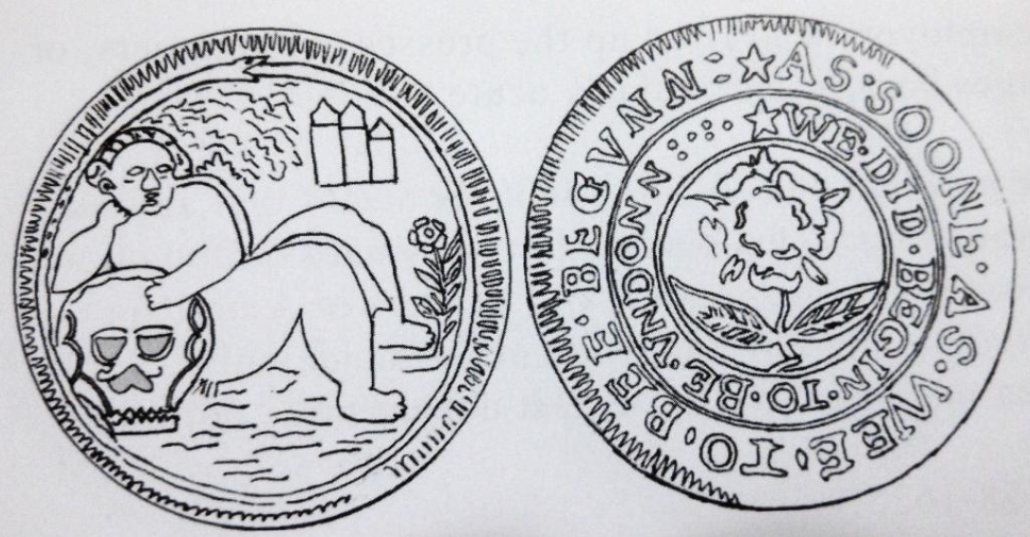Raleigh Plantation Tokens
Anyone who knows me knows that I love to research coins and tokens with even the loosest connection to North Carolina. Well, today’s token may represent the most remote connection yet. In the modern era of cataloguing, meaning the last 100 years or so, it has traded hands as the Raleigh Plantation Token despite having almost nothing to do with the namesake, Sir Walter Raleigh.
If you have not heard of this token, all is forgiven — it is a rather esoteric issue and few trade with any regularity as most are ensconced in established collections. It is primarily this name, Raleigh Plantation Token, with which I take issue. We enjoy a hobby where misnomers are abound.
The moniker comes from a presumed association with the failed colony at Roanoke. This token bears the words AS SOONE AS WEE TO BEE BEGUNN, WE DID BEGIN TO BE UNDONN. On the broader scale this alludes to the human condition of birth leading to an eventual and unavoidable death. Although vague, one can see how this might seemingly refer to that failed experiment of an early colony on Carolina soil.
The obverse of the token has a portly cherub reclining against an image of a skull. It is certainly a contender for one of the creepiest and most macabre tokens available. This design is encircled by a serpent devouring its own tail, known as an ouroboros, meant to symbolize eternity and constant regeneration. It should be noted that on this particular token, as on many, terms such as obverse and reverse end up being assigned arbitrarily. I tend to see the side with the stronger figural element as the obverse, though I will admit great subjectivity to this completely unscientific method.
On what we might call the reverse you will find the aforementioned motto surrounding a rose. Early numismatists seem to have mistaken this flora with a tobacco leaf, lending credence to the erroneous Sir Walter Raleigh connection. By happenstance, there may be more relevance with a proper rose as Sir Walter Raleigh saw his political influence expand under Queen Elizabeth, last in the Tudor Line.

A 1634 writing by George Wither pictured a strangely similar rose within an ouroboros accompanied by the quote: “Time is a fading flower that’s found within eternities wide round.” (source: In Yankee Doodle’s Pocket by Will Nipper).
With the modern benefit of cumulative numismatic knowledge, gathered from all who studied these tokens before us, we are able to establish with some certainty that this was manufactured in the mid 17th century. Assuming there was any kind of Sir Walter Raleigh connection, this would have been a posthumous release. Also it would have been coined almost seventy years after Roanoke. It begs the question too, why would a failure be commemorated?
As much as I would love to believe this token has any kind of relationship to the early Roanoke Colony or Sir Walter Raleigh himself, the supporting data just isn’t there. As with most things fact tends to confound the prettiest of theories. If all things were possible and we could travel back in time and place one of these tokens into the hand of Raleigh, or any other Roanoke colonist, my guess is that it would be met with looks of confusion.
More than likely the somewhat diminutive, 31 mm diameter, token was produced in London or Birmingham as a Mortuary piece of sorts, given the depiction and subject matter. There is a possibility it was a merchant token, with the exact purpose lost to the ages. If there is one thing worth noting it is that in our hobby names tend to stick. With little to offer as evidence supporting any Raleigh connection, this token has recently crossed an auction block or two billed as The Raleigh Plantation Token. Notably the John J. Ford sale in January of 2006 where Lot 671 boasted a brass version of this token, and then later in the same calendar year the Norweb sale had not one but TWO! (silvered brass version and copper version; Lots 1146 & 1147 respectively) In each instance being described without pause as a Raleigh Plantation Token, even if no reasoning was given for the name. Another hundred years from now it will be no different — names have lasting power!
— Greg Capps
Sources:
Mossman, Philip; Money of the American Colonies and Confederation: A Numismatic, Economic, and Historical Correlation; Published by ANS; 1993.
Nipper, Will; In Yankee Doodle’s Pocket: The Myth, Magic and Politics of Money in Early America; Bowmanstone Press; 2008.
Stack’s Public Auction; Sale of the Norweb Collection and Other Important Properties; November 7th – 8th, 2006; Baltimore, MD.
Stack’s Public Auction; Sale of the John J. Ford Collection: Coins, Medals and Currency; Part XIII; January 16th, 2006; New York, NY.
Wither, George; A Collection of Emblemes Ancient and Modern: Quickened With Metrical Illustrations, both Moral and Divine; Publisher Richard Royston, London; 1634.



